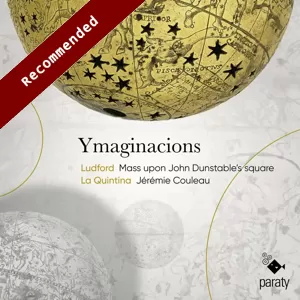
Ymaginacions – Mass upon John Dunstable’s square
La Quintana/Jérémie Couleau
rec. 2022, Abbaye de Loc-Dieu, Martiel, France
Texts and translations included
Paraty 1123291 [62]
Nicholas Ludford, one of the outstanding musicians of his age, was based in London with the Chapel Royal. He served as an organist at two significant London churches. His seven Lady Masses that survive can be dated to the 1520s. There is one for each day of the week, the only extant complete scheme for daily Lady Masses for use throughout the year. The one recorded here is known as Missa Feria II. Each includes texts for the Proper and the Ordinary. This unique collection is of considerable importance. The part books include what we can call a measured notation, but the tenor book has parts of the alternatim of the Kyrie, Gloria and Credo. There are also single chants for the Alleluia and Sequences. This partbook may have been used by the organist who played just the melodies and plainsongs, but it is more likely that he would have improvised descants around the chant.
The plan for each mass varies only a little from day to day. Jerémie Couleau, the director of Ensemble La Quintina, wrote excellent booklet notes. He says that the disc offers us the Mass for the second day. The booklet also gives the square chant melody and a list of the verses set to music. Therefore, the Kyrie, Gloria and Credo are given in alernatim. The performance employs soloists, the three-part voices and Discants played on the organetto. That is also listed under the heading ‘Contrapuntal technique’.
But what about the square? I advise you to peruse the notes at least once, as they may take a little time to grasp. Basically, a probably well-known melodic fragment (here supposedly by Dunstable who had lived almost a century before Ludford) is taken to improvise upon and to compose upon. Written in square notation, it just gives the performer a basic outline on which to work and on which other parts they can add above, using their most fertile imagination – hence the title of the disc. It is not unlike cantus firmus except, of course, extemporised. The ensemble have made quite a study of this lost art. On an earlier disc (review), which sadly I have not heard, they took Ludford’s another Feria Lady Mass, Missa Sabato, and worked with it in a similar manner.
The three-part Sanctus, Benedictus and Agnus Ddei are in Ludford’s usual mellifluous, lyrical style, with occasional doubling by the organetto. Perhaps unusually, the artists have also worked within sections of the extracts from William Whitbroke’s Mass Upon the Square, especially Ite Missa est. Whitbroke is associated with Christchurch Cathedral, Oxford. We can also hear these wonderful voices top and tail the mass with two carols; the less well known An Heavenly Songe is especially welcome.
We also get what is called here a Glose, an improvisation effectively continuing the concept of Ymaginacions. In fact, we have two: one on the folksong Byrd one brere (Bird in the Briar), another on the plainchant Afferentur regi virgines. These are played on the organetto with a certain amount of odd wheezing noises as air enters and then dissipates at the end.
Ensemble La Quitina consist of just four musicians: a soprano, a countertenor, a tenor and an organetto. They take deep interest in Nicholas Ludford’s music. It was an utter puzzle to me for years why his quite extensive surviving output was so overlooked, even when his contemporaries were becoming much better known. In the 1990s, Cardinall’s Musick brought out four discs of his major masses (on ASV), very well received. This issue, with all of the texts provided, offers a new and exciting way of discovering Ludford’s very fine music.
Gary Higginson
Help us financially by purchasing from


Previous review: Johan van Veen (February 2024)
Contents
anon.
Nowel syng we bothe al and som
Nicholas Ludford (c1490-1557)
Missa Feria II:
Kyrie
Gloria
Alleluya. Post partum Virgo
Sequentia. Post partum Virgo
Credo
plainchant
Afferentur regi virgines (glose)
Nicholas Ludford
Missa Feria II:
Sanctus
Agnus Dei
William Whitbroke (c1501-1569)
Mass upon the square:
[Ite missa est]
anon.
Bryd one brere (glose)
An Hevenly Songe

















